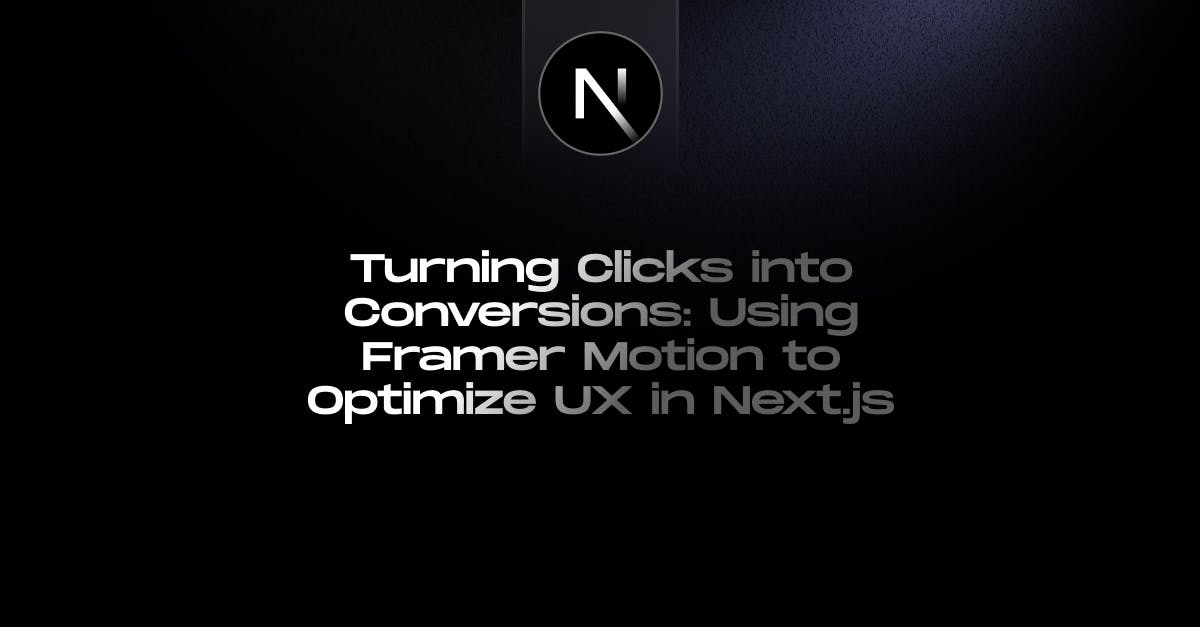October 5, 2025
Turning Clicks into Conversions: Using Framer Motion to Optimize UX in Next.js

Md. Saad

Conversions are influenced by both traffic and the ease and confidence with which users can interact with your website in the fast-paced digital product world. Next.js powers fast apps, and perfect animations are made possible by Framer Motion. Together, these two powerful tools can optimize user experience and boost conversion rates.
But adding motion alone isn't enough; you also need to know how to use it wisely.
Why Motion Influences Conversions
Motion is not merely ornamentation. According to UX psychology, visual feedback is a crucial part of user trust. Users are more likely to stop an action when they click a button and nothing happens, even for a brief moment. Motion fills the space by:
- Users are reassured: Feedback animations verify that taps and clicks were recorded.
- Directing attention: Call-to-actions and important content are naturally drawn to animated elements.
- Journey smoothing: Page or state transitions reduce cognitive strain and friction.
- Bringing happiness: Users are more likely to interact when they have a positive impression from brief, well-timed interactions.
When applied wisely, these ideas can speed up decision-making and boost conversions. Conversions in the fast-paced world of digital products are influenced by both traffic and the speed at which users can take desired actions.
Framer Motion as a UX Optimizer in Next.js
One of the most developer-friendly motion libraries is Framer Motion. Three areas are where conversion optimization is valuable:
- At-scale micro-interactions
Motion makes it simple to incorporate confirmation animations, tap reactions, and hover effects into your website without making it bloated. A more dependable and conversion-friendly experience is the result of these small details.
- Regular storytelling via travel
Next.js allows users to quickly switch between routes and components. This speed may seem abrupt in the absence of motion. Motion transitions provide coherence, giving users the impression that they are following a path rather than hopping between broken screens.
- Adaptability for iterations and testing
Product teams can A/B test different animations (such as timing, easing, or emphasis) to find out which motion strategies increase conversions the most because Motion integrates seamlessly with React's component architecture.
Strategic Applications for Higher Conversions
Not every motion is created equal. Animations in Next.js apps should highlight important user touchpoints in order to effectively increase conversions:
- Buttons for Calls to Action
Users' attention is directed, and their confidence to click is boosted by a subtle color shift or scale.
- Onboarding & Sign-up Flows
Sign-up and Onboarding Processes seem quicker and easier to use when they have animated flows.
- Checkout Journeys: Users are kept interested until the transaction is finished thanks to progress indicators, animated confirmations, and seamless transitions.
- Form Validation and Error States
Drop-off is reduced by animated cues (shakes, fades, and highlights) that highlight mistakes without making them more noticeable.
- Content Disclosure and Narration
Scroll-based animations have the potential to increase dwell time and conversion rates by holding visitors' attention for longer.
- Motion drives clarity, continuity, and emotional reassurance, all of which are advantageous for each of these touchpoints.and conversion rates.
Each of these touchpoints benefits from clarity, continuity, and emotional reassurance—all powered by motion.
Best Practices for Conversion-Focused Motion
Put function before beauty: Instead of detracting from a goal, animation should support it.
Speed matters: While slow animations create friction, quick, snappy animations feel responsive and up to date.
Accessibility first: accessibility provide reduced-motion options to satisfy user inclinations.
Analyze the effect: Determine whether motion adjustments increase conversions by using analytics tools.
These figures show how motion, animation, micro-interaction, and UX improvements can boost conversions or reduce friction. They are relevant to the use of motion (such as Framer Motion) in user experience. Numbers vary depending on the context, as usual, but these offer compelling evidence:
Conclusion
The seamlessness of Framer Motion and Next.js performance work together to create an environment where users commit rather than just click. They follow the directed flow, have faith in the interface, and are comforted at every turn.
Motion-driven UX is ultimately about lowering friction and uncertainty. That's the difference between a visitor who leaves and a customer who stays in the conversion game.
Ready to bring motion-driven design to your Next.js website and boost conversions? Contact us today and let’s build a fast, engaging, and conversion-focused experience for your users.

